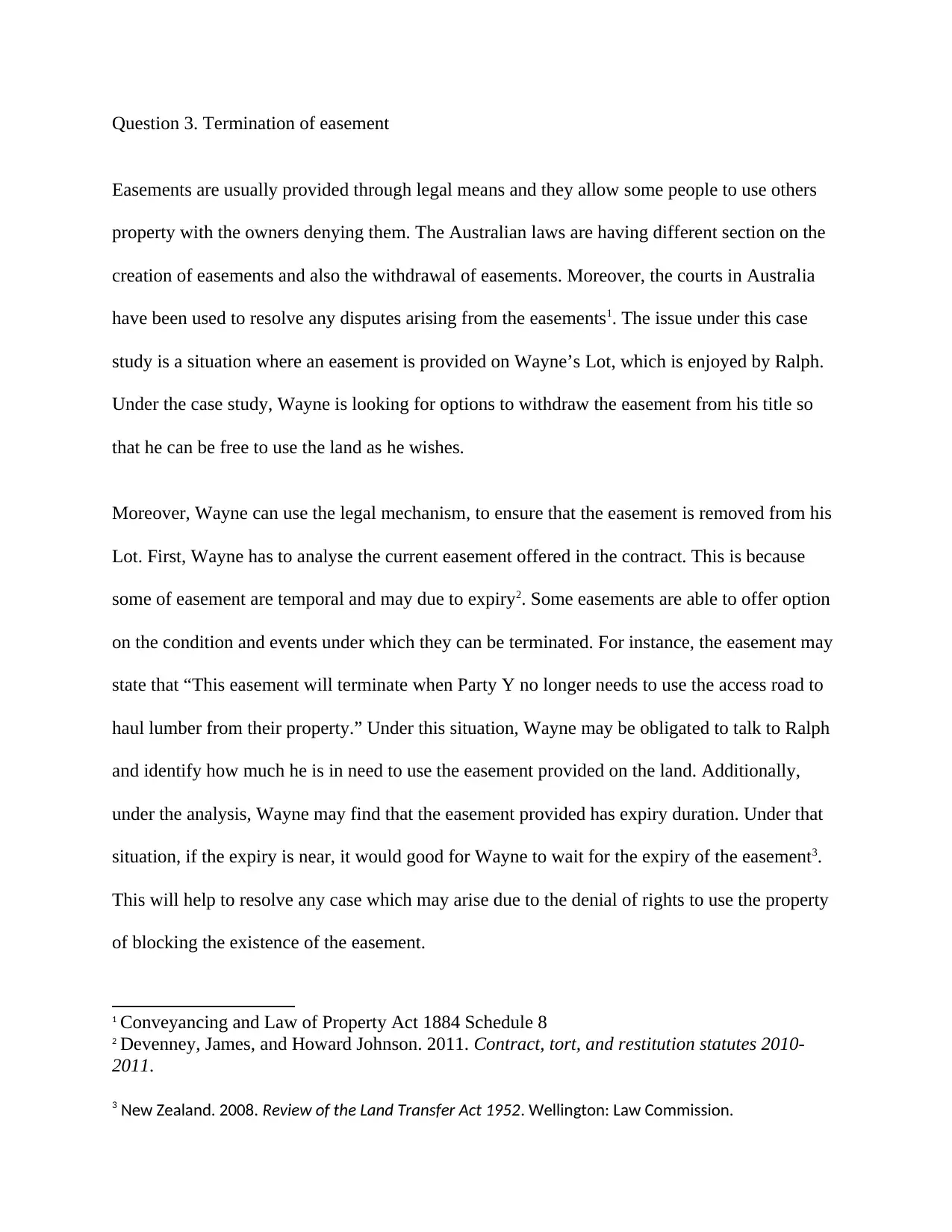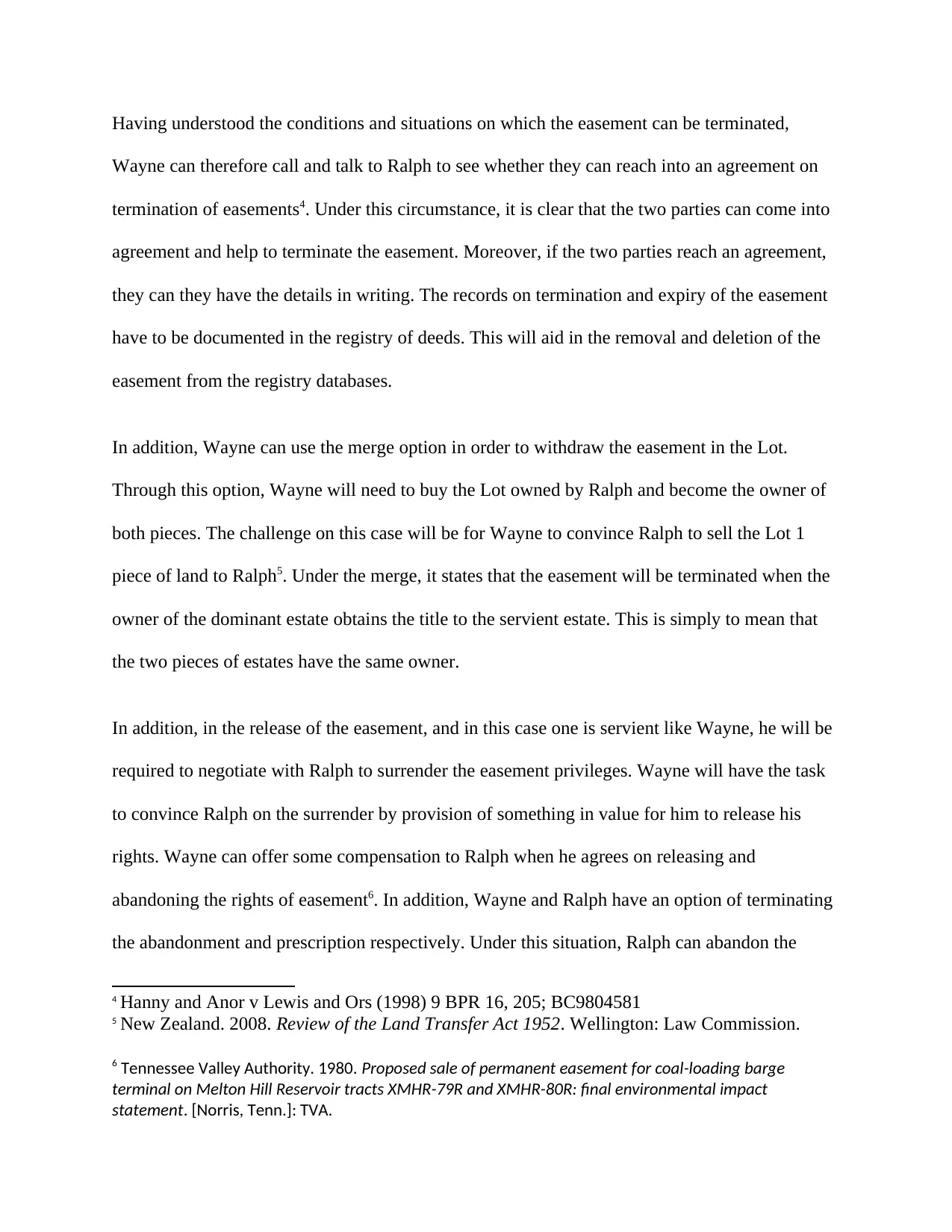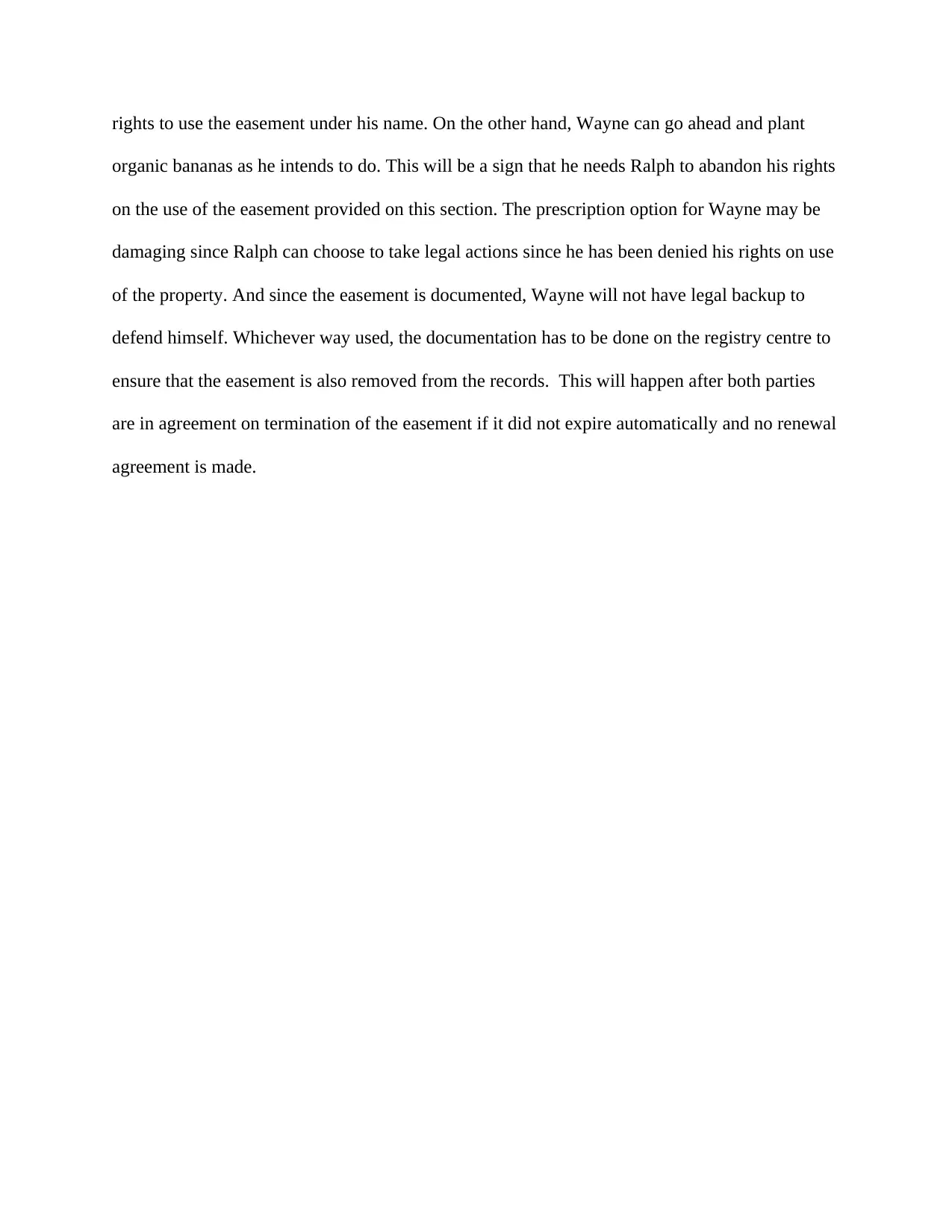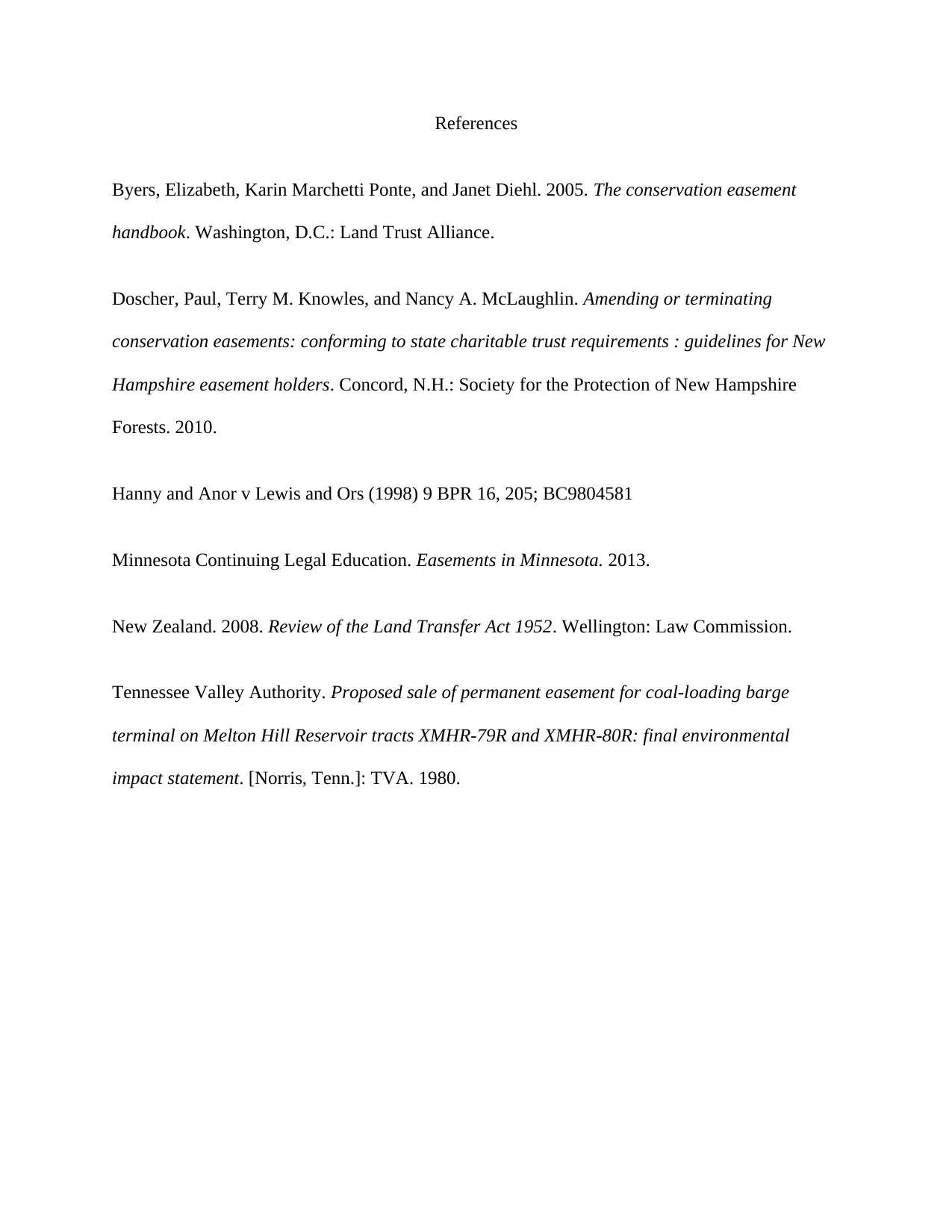Case Study on Easement Termination: Legal Analysis and Strategies
VerifiedAdded on 2020/04/15
|5
|956
|244
Case Study
AI Summary
This case study examines the legal options available to Wayne in terminating an easement granted to Ralph on Wayne's property. The analysis explores several strategies, including reviewing the easement contract for expiration clauses or conditions, negotiating a termination agreement with Ralph, merging the properties, offering compensation for the release of easement rights, and the implications of abandonment and prescription. The document emphasizes the importance of documenting any termination agreements in the registry of deeds to ensure the easement is legally removed. It also highlights the potential legal ramifications of Wayne's actions, especially if Ralph's rights are denied, and underscores the need for careful consideration of all legal mechanisms involved in easement termination under Australian law. The case study provides a comprehensive overview of the legal processes and considerations for resolving easement disputes.

Name:
Course:
Professor:
Date:
Course:
Professor:
Date:
Paraphrase This Document
Need a fresh take? Get an instant paraphrase of this document with our AI Paraphraser

Question 3. Termination of easement
Easements are usually provided through legal means and they allow some people to use others
property with the owners denying them. The Australian laws are having different section on the
creation of easements and also the withdrawal of easements. Moreover, the courts in Australia
have been used to resolve any disputes arising from the easements1. The issue under this case
study is a situation where an easement is provided on Wayne’s Lot, which is enjoyed by Ralph.
Under the case study, Wayne is looking for options to withdraw the easement from his title so
that he can be free to use the land as he wishes.
Moreover, Wayne can use the legal mechanism, to ensure that the easement is removed from his
Lot. First, Wayne has to analyse the current easement offered in the contract. This is because
some of easement are temporal and may due to expiry2. Some easements are able to offer option
on the condition and events under which they can be terminated. For instance, the easement may
state that “This easement will terminate when Party Y no longer needs to use the access road to
haul lumber from their property.” Under this situation, Wayne may be obligated to talk to Ralph
and identify how much he is in need to use the easement provided on the land. Additionally,
under the analysis, Wayne may find that the easement provided has expiry duration. Under that
situation, if the expiry is near, it would good for Wayne to wait for the expiry of the easement3.
This will help to resolve any case which may arise due to the denial of rights to use the property
of blocking the existence of the easement.
1 Conveyancing and Law of Property Act 1884 Schedule 8
2 Devenney, James, and Howard Johnson. 2011. Contract, tort, and restitution statutes 2010-
2011.
3 New Zealand. 2008. Review of the Land Transfer Act 1952. Wellington: Law Commission.
Easements are usually provided through legal means and they allow some people to use others
property with the owners denying them. The Australian laws are having different section on the
creation of easements and also the withdrawal of easements. Moreover, the courts in Australia
have been used to resolve any disputes arising from the easements1. The issue under this case
study is a situation where an easement is provided on Wayne’s Lot, which is enjoyed by Ralph.
Under the case study, Wayne is looking for options to withdraw the easement from his title so
that he can be free to use the land as he wishes.
Moreover, Wayne can use the legal mechanism, to ensure that the easement is removed from his
Lot. First, Wayne has to analyse the current easement offered in the contract. This is because
some of easement are temporal and may due to expiry2. Some easements are able to offer option
on the condition and events under which they can be terminated. For instance, the easement may
state that “This easement will terminate when Party Y no longer needs to use the access road to
haul lumber from their property.” Under this situation, Wayne may be obligated to talk to Ralph
and identify how much he is in need to use the easement provided on the land. Additionally,
under the analysis, Wayne may find that the easement provided has expiry duration. Under that
situation, if the expiry is near, it would good for Wayne to wait for the expiry of the easement3.
This will help to resolve any case which may arise due to the denial of rights to use the property
of blocking the existence of the easement.
1 Conveyancing and Law of Property Act 1884 Schedule 8
2 Devenney, James, and Howard Johnson. 2011. Contract, tort, and restitution statutes 2010-
2011.
3 New Zealand. 2008. Review of the Land Transfer Act 1952. Wellington: Law Commission.

Having understood the conditions and situations on which the easement can be terminated,
Wayne can therefore call and talk to Ralph to see whether they can reach into an agreement on
termination of easements4. Under this circumstance, it is clear that the two parties can come into
agreement and help to terminate the easement. Moreover, if the two parties reach an agreement,
they can they have the details in writing. The records on termination and expiry of the easement
have to be documented in the registry of deeds. This will aid in the removal and deletion of the
easement from the registry databases.
In addition, Wayne can use the merge option in order to withdraw the easement in the Lot.
Through this option, Wayne will need to buy the Lot owned by Ralph and become the owner of
both pieces. The challenge on this case will be for Wayne to convince Ralph to sell the Lot 1
piece of land to Ralph5. Under the merge, it states that the easement will be terminated when the
owner of the dominant estate obtains the title to the servient estate. This is simply to mean that
the two pieces of estates have the same owner.
In addition, in the release of the easement, and in this case one is servient like Wayne, he will be
required to negotiate with Ralph to surrender the easement privileges. Wayne will have the task
to convince Ralph on the surrender by provision of something in value for him to release his
rights. Wayne can offer some compensation to Ralph when he agrees on releasing and
abandoning the rights of easement6. In addition, Wayne and Ralph have an option of terminating
the abandonment and prescription respectively. Under this situation, Ralph can abandon the
4 Hanny and Anor v Lewis and Ors (1998) 9 BPR 16, 205; BC9804581
5 New Zealand. 2008. Review of the Land Transfer Act 1952. Wellington: Law Commission.
6 Tennessee Valley Authority. 1980. Proposed sale of permanent easement for coal-loading barge
terminal on Melton Hill Reservoir tracts XMHR-79R and XMHR-80R: final environmental impact
statement. [Norris, Tenn.]: TVA.
Wayne can therefore call and talk to Ralph to see whether they can reach into an agreement on
termination of easements4. Under this circumstance, it is clear that the two parties can come into
agreement and help to terminate the easement. Moreover, if the two parties reach an agreement,
they can they have the details in writing. The records on termination and expiry of the easement
have to be documented in the registry of deeds. This will aid in the removal and deletion of the
easement from the registry databases.
In addition, Wayne can use the merge option in order to withdraw the easement in the Lot.
Through this option, Wayne will need to buy the Lot owned by Ralph and become the owner of
both pieces. The challenge on this case will be for Wayne to convince Ralph to sell the Lot 1
piece of land to Ralph5. Under the merge, it states that the easement will be terminated when the
owner of the dominant estate obtains the title to the servient estate. This is simply to mean that
the two pieces of estates have the same owner.
In addition, in the release of the easement, and in this case one is servient like Wayne, he will be
required to negotiate with Ralph to surrender the easement privileges. Wayne will have the task
to convince Ralph on the surrender by provision of something in value for him to release his
rights. Wayne can offer some compensation to Ralph when he agrees on releasing and
abandoning the rights of easement6. In addition, Wayne and Ralph have an option of terminating
the abandonment and prescription respectively. Under this situation, Ralph can abandon the
4 Hanny and Anor v Lewis and Ors (1998) 9 BPR 16, 205; BC9804581
5 New Zealand. 2008. Review of the Land Transfer Act 1952. Wellington: Law Commission.
6 Tennessee Valley Authority. 1980. Proposed sale of permanent easement for coal-loading barge
terminal on Melton Hill Reservoir tracts XMHR-79R and XMHR-80R: final environmental impact
statement. [Norris, Tenn.]: TVA.
⊘ This is a preview!⊘
Do you want full access?
Subscribe today to unlock all pages.

Trusted by 1+ million students worldwide

rights to use the easement under his name. On the other hand, Wayne can go ahead and plant
organic bananas as he intends to do. This will be a sign that he needs Ralph to abandon his rights
on the use of the easement provided on this section. The prescription option for Wayne may be
damaging since Ralph can choose to take legal actions since he has been denied his rights on use
of the property. And since the easement is documented, Wayne will not have legal backup to
defend himself. Whichever way used, the documentation has to be done on the registry centre to
ensure that the easement is also removed from the records. This will happen after both parties
are in agreement on termination of the easement if it did not expire automatically and no renewal
agreement is made.
organic bananas as he intends to do. This will be a sign that he needs Ralph to abandon his rights
on the use of the easement provided on this section. The prescription option for Wayne may be
damaging since Ralph can choose to take legal actions since he has been denied his rights on use
of the property. And since the easement is documented, Wayne will not have legal backup to
defend himself. Whichever way used, the documentation has to be done on the registry centre to
ensure that the easement is also removed from the records. This will happen after both parties
are in agreement on termination of the easement if it did not expire automatically and no renewal
agreement is made.
Paraphrase This Document
Need a fresh take? Get an instant paraphrase of this document with our AI Paraphraser

References
Byers, Elizabeth, Karin Marchetti Ponte, and Janet Diehl. 2005. The conservation easement
handbook. Washington, D.C.: Land Trust Alliance.
Doscher, Paul, Terry M. Knowles, and Nancy A. McLaughlin. Amending or terminating
conservation easements: conforming to state charitable trust requirements : guidelines for New
Hampshire easement holders. Concord, N.H.: Society for the Protection of New Hampshire
Forests. 2010.
Hanny and Anor v Lewis and Ors (1998) 9 BPR 16, 205; BC9804581
Minnesota Continuing Legal Education. Easements in Minnesota. 2013.
New Zealand. 2008. Review of the Land Transfer Act 1952. Wellington: Law Commission.
Tennessee Valley Authority. Proposed sale of permanent easement for coal-loading barge
terminal on Melton Hill Reservoir tracts XMHR-79R and XMHR-80R: final environmental
impact statement. [Norris, Tenn.]: TVA. 1980.
Byers, Elizabeth, Karin Marchetti Ponte, and Janet Diehl. 2005. The conservation easement
handbook. Washington, D.C.: Land Trust Alliance.
Doscher, Paul, Terry M. Knowles, and Nancy A. McLaughlin. Amending or terminating
conservation easements: conforming to state charitable trust requirements : guidelines for New
Hampshire easement holders. Concord, N.H.: Society for the Protection of New Hampshire
Forests. 2010.
Hanny and Anor v Lewis and Ors (1998) 9 BPR 16, 205; BC9804581
Minnesota Continuing Legal Education. Easements in Minnesota. 2013.
New Zealand. 2008. Review of the Land Transfer Act 1952. Wellington: Law Commission.
Tennessee Valley Authority. Proposed sale of permanent easement for coal-loading barge
terminal on Melton Hill Reservoir tracts XMHR-79R and XMHR-80R: final environmental
impact statement. [Norris, Tenn.]: TVA. 1980.
1 out of 5
Related Documents
Your All-in-One AI-Powered Toolkit for Academic Success.
+13062052269
info@desklib.com
Available 24*7 on WhatsApp / Email
![[object Object]](/_next/static/media/star-bottom.7253800d.svg)
Unlock your academic potential
Copyright © 2020–2025 A2Z Services. All Rights Reserved. Developed and managed by ZUCOL.





